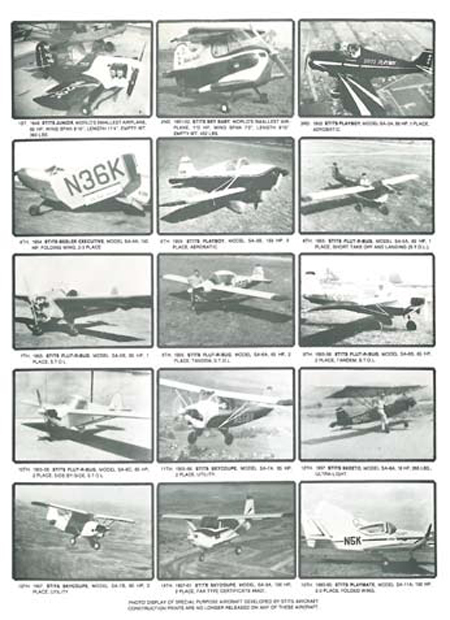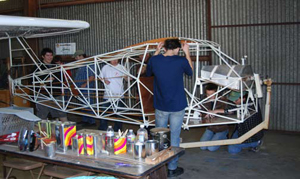|
Unless your EAA membership number is below 100,000, you may not have heard of Ray Stits. However, few people outside of the Poberezny family had as much influence on the early homebuilt aircraft movement as Ray Stits. Today, at the age of 90, he’s still going strong as a pilot, mentor, and founding member of EAA Chapter One at historic Flabob Airport. Ray has had a sterling career as an aircraft designer, aircraft mechanic and creator of the Stits Process, known today as Polyfiber. Between 1948 and 1965, he designed and built 15 airplanes. Except for the first two designs, he test flew them all. The reason for not flying the first two relates to the nature of the aircraft: they were the world’s smallest monoplane and then the world’s smallest biplane. Ray was too big/heavy to fit into them. They captured world attention, generated considerably revenue on the airshow circuit
and resulted in a whole lot of requests for plans.
The incentive to build “Junior”, the monoplane, came from a discussion about the world’s smallest airplane. Someone mentioned Steve Wittman’s little racer with a 13’ span and Ray queried whether or not he could fly something with a 10’10” wingspan. One of the participants in that conversation said it wouldn’t be possible and that was all it took. Ray started building. He’d actually been thinking about it for a long time and proceeded with a 40hp engine from an Aeronca. That got changed to a 65 hp Continental. The plane was a handful and after the third crash on the fifth test flight, Ray shortened the wings to 8’10” and attached tip gates to generate more lift and better aileron control. He found a new pilot, Bob Starr, a former P-51 pilot. In 1950, Junior was a big hit in airshows. He began thinking about a larger sport plane that would be easy to build and fly, but he got sidetracked with another design: his quest to create the world’s smallest biplane.

In May of 1952, he introduced the Stits Sky Baby, a biplane with a 7’2” wingspan. Once again he drew tremendous response from newspapers, magazines and the newsreel companies. And once again he got busy on the airshow circuit…but not for long. After one season, and 25 hours of flying time, the Sky Baby was given to the Smithsonian Institute. In 1963 it was sent to the Experimental Aircraft Association’s museum where it remains on long term loan. Junior wound up on a scrap heap after an off airport landing. Requests were pouring in for plans for both of his midget aircraft, but Ray knew most people couldn’t handle the complexities
of construction or the flying limitations of the two designs. Not being one to pass up an opportunity, however,
he designed, built and test flew the Stits Playboy. It was a single seat, low wing, strut braced, aerobatic airframe that was designed to fly with 85 hp to 160hp engines.
Capitalizing on his fame for the miniature, Ray began selling plans. Realizing that a lot of builders were having problems securing aircraft grade materials, he started stocking and selling materials. He was into his second decade as an aircraft mec hanic when the homebuilt movement began to take off and he slowly transitioned into an early version of Aircraft Spruce & Specialty.
His original Playboy has been rebuilt and now resides in the EAA museum. One of the Playboy builders
eventually sold his project to a young aviator who quickly rebuilt the wing, getting rid of the struts and converting it from a fabric covered wooden frame to an aluminum wing. Once finished, it was called the RV-1. The rebuilder was Dick VanGrunsven and his first airplane has been rebuilt and will be donated to the EAA museum this summer.
By 1951, after living in Michigan and Arizona, Ray had moved to Flabob Airport in Riverside, California. He recalled the day he brought the “Junior” over to that airport. “In those days, anything you built yourself made you a kook. You’re a strange guy if you built airplanes. A lot of people told me: ‘You’re crazy doing that’”. In 1953, Ray got a letter from a man named Poberezny. The letter sat in an office at the airport for six weeks before someone finally delivered it to Ray. Paul Poberezny had heard of Ray’s work with homebuilts and had written to invite him to join a new organization he’d founded called the Experimental Aircraft Association.

Ray liked the concept and suggested to Paul that he be allowed to establish a Chapter of the EAA at Flabob. A couple months later, EAA had amended their bylaws to allow for Chapters and Ray was authorized to set up the first one. He got a dozen friends together and founded Chapter One. It’s still very active and leads all the other chapters in the number of Young Eagles they fly annually. Today there are over 700 active EAA Chapters.
Ray went on designing new airplanes. Today the designs look dated, like the cars from the Golden Age of Automobiles (1948 – 1959). Aside from the first two designs, there weren’t any concepts that could be labeled radical or futuristic (we’d have to wait for Burt Rutan for that kind of design stream). However, they were
all solid designs that offset their kind of plain-Jane styling with functional simplicity and they were on the market at a time when it was still possible to build a complete airplane (including prop and engine) for less than a thousand dollars.
The list of Ray’s designs includes:
1. Stits Junior, world’s smallest monoplane, 8’10” span, 1948
2. Stits Sky Baby, world’s smallest biplane, 7’2” span, 1952
3. Stits SA-3A, single place, 1952
4. Stits-Besler Executive, folding wing, 1954
5. Stits Playboy, two place, 1954
6. Stits Flut-R-Bug, SA-5A, 1955
7. Stits Flut-R-Bug, SA-5B, 1955
8. Stits Flut-R-Bug, SA-6A, two place, tandem, 1955
9. Stits Flut-R-Bug, SA-6B, two place, tandem, 1955
10. Stits Flut-R-Bug, SA-6C, two place, side by side, 1956
11. Stits Skycoupe, SA-7A, two place, 1956
12. Stits Skeeto, 265-pound ultralight, 1957
13. Stits Skycoupe, SA-7B, two place, 1957
14. Stits Skycoupe, SA-9A, two place, Type Certified, 1957-61
15. Stits Playmate, 2/3 place, folding wing, 1963-65
It reached the point where people were
really wondering what Ray was going to bring to EAA’s annual convention in Rockford next. He was a prolific designer and builder.
In the 1960s Ray began to realize that the business of designing homebuilts and selling plans was very time consuming and not terribly lucrative. Around 1961, Ray went out to the back of his shop to dispose of some scrap aircraft covering that had been removed from an airplane. Disposal in those days was done with a match. But when he bent over to torch the nitric dope covered fabric, the stuff blew up in his face. The flammability of
the covering got him thinking and he began a course of study that made him a chemist, leading over several years to the creation of a new covering material and a form of paint that was fire-resistant. Stits Polyfiber was born and it became such a hit in the homebuilt and restoration communities that Ray stopped selling all
other forms of aircraft materials and by 1969, he removed all of his aircraft plans from the market. He spent the next couple of decades selling fabric and paint of his own creation. Ray is retired now and Jon Goldenbaum runs Polyfiber, which is still based on the famous “Stits Process”.
Ray Stits had a big influence in making Flabob Airport a major force in the homebuilt aircraft movement. Ray and the airport attracted other figureheads like Lou Stolp of Starduster fame, Ed Marquart, who designed the Marquart Charger, and Bill Turner, who created Repeat Aircraft which built three of the four fabulous replica racers owned by Tom Wathen. There
was a time when Flabob Airport and EAA Chapter One was one of the busiest places in the world for aircraft construction projects.
A while back Ray offered some advice to people thinking about designing a new
homebuilt: “Get a lot of ideas, do a lot of testing, don’t get involved with partners, don’t promise something you might not be able to deliver, don’t extend yourself beyond your own financial means.”
Ray Stits went on to become recognized as a Master Mechanic and recently became one of a handful of people who has also earned the title of Master Pilot. He still flies an LSA and stays involved with events going on at Flabob Airport. His latest gesture was an offer to install a 12,000 gallon fuel tank on the airport’s fuel farm so that Flabob can become the
first airport in the state of California to offer mogas to homebuilders and those who own a certificated aircraft with the proper STC. He’s also involved in working with students at the Flabob Airport Preparatory Academy who are rebuilding a Stits Skycoupe.
Ray Stits made a far-reaching and inspirational contribution to the early
days of the homebuilt aircraft movement in this country. His influence on the EAA Chapter Network and the early designers and builders of homebuilts was profound and deserves to be reviewed. Like Paul Poberezny, Ray Stits was a real pioneer.

|




